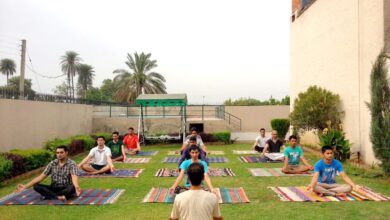Somatic Yoga: A Journey Beyond Traditional Practice for Mind-Body Connection
Yoga has been incredibly popular in recent years due to its many advantages for both physical and emotional well-being. Somatic yoga is a novel approach to yoga that focuses on the physical postures, breath control, and meditation that are commonly taught in regular programs. This approach transcends the physical by highlighting the close relationship between the mind and body and encouraging awareness of both the physical and emotional aspects of one’s being. By developing a deep mind-body connection, somatic yoga invites practitioners to set out on a journey that improves their general well-being.
Comprehending Somatic Yoga
The Greek word “soma,” which describes the body as seen from within, is where the word “somatic” comes from. Somatic yoga incorporates the concepts of somatics, an academic discipline that highlights the body’s interior experience, into conventional yoga techniques. Somatic yoga promotes a more intuitive approach, in contrast to traditional yoga, which frequently places an emphasis on alignment and performance. It encourages practitioners to become aware of their experiences, investigate their bodies, and tune in to their inner wisdom.
Somatic yoga helps people rediscover their bodies by combining slow, meditative movements with an emphasis on breathing. Understanding how emotions are stored in the body and how physical tension can take many different forms is fostered by this practice. This all-encompassing method not only improves strength and flexibility in the body but also fosters psychological health and emotional rehabilitation.
The Somatic Yoga Philosophical Framework
Somatic yoga is essentially based on the knowledge that the mind and body are closely related. This way of thinking is consistent with many old traditions, such as yoga, which acknowledge the influence of thoughts and emotions on physical well-being. People who engage in somatic activities are encouraged to recognize and accept their emotions, pay attention to their physical experiences, and develop self-compassion.
According to somatic yoga, memories of prior traumas, emotions, and experiences are stored in our bodies. Through cultivating consciousness of these encounters, professionals can initiate the release of pent-up tension and establish a place for recovery. People can regain control over their bodies and develop a secure and comfortable sense of self via this process, which has the potential to be transformative.
The advantages of somatic yoga include improved body awareness Increasing bodily awareness is one of the main advantages of somatic yoga. In order to identify regions of tension, discomfort, or emotional weight, practitioners learn to tune into their bodily feelings. This increased awareness fosters compassion and self-care by enabling people to respond to their bodies’ demands more skillfully.
1. Emotional Release:
Somatic yoga offers a secure setting where people can examine and let go of repressed feelings. Practitioners may feel a sense of liberation and emotional healing when they perform breathing techniques and gentle movements that release pent-up emotions. For people who are under chronic stress or have experienced trauma, this release may be especially helpful.
2. Stress Reduction:
Somatic yoga’s conscious movement, breath awareness, and relaxation techniques work together to relieve tension and encourage relaxation. People can develop a sense of balance and relaxation by practicing this, which can assist to release tension and anxiety.
3. Increased Mobility and Flexibility:
The emphasis of somatic yoga is on fluid, soft movements that increase mobility and flexibility. In contrast to traditional yoga, which frequently emphasizes forcing the body into particular poses, somatic yoga invites people to freely explore their range of motion. This strategy may result in better physical health and increased mobility comfort.
Somatic yoga promotes mindfulness and presence by encouraging practitioners to live in the present moment. People can develop a closer relationship with themselves and their environment by focusing on their breath and physical sensations. A deeper appreciation for life as well as a higher potential for happiness and fulfillment can result from practicing mindfulness.
4. Integration of Mind and Body:
Somatic yoga promotes a comprehensive sense of well-being by emphasizing the integration of mind and body. Practitioners can get a deeper awareness of themselves and their experiences by recognizing and addressing the interaction between ideas, feelings, and bodily sensations.
How to Do Somatic Yoga
There are several places to practice somatic yoga, such as studios, homes, and outdoor spaces. When practicing somatic yoga, keep the following points in mind:
1. Establish a Secure Area:
Select a peaceful, cozy space where you may practice without interruptions. You should feel comfortable and safe in this area, free to unwind and discover your body.
2. Start with Breath Awareness:
Pay attention to your breath at the beginning of your session. Observe your natural breathing pattern for a few moments, taking note of any tense or uncomfortable spots. As you bring yourself into the present now, notice how your breath becomes more relaxed and deeper.
3. Move Calmly:
Include mild motions that your body finds pleasant. somatic yoga to extending your range of motion and letting your body move freely without inhibition. Observe any new feelings that come up and let them direct your actions.
4. Put mindfulness into practice:
Remain conscious of your thoughts, feelings, and physical sensations as you practice. Refocus your attention softly on your breathing and the here and now if you find yourself getting sidetracked.
5. Include Regenerative Poses:
Incorporate healing positions that alleviate tension and encourage relaxation. Asanas like Child’s Pose, Supported Bridge Pose, and Legs-Up-the-Wall can enhance your sense of body awareness and promote profound relaxation.
6. Consider and Include:
Spend some time thinking back on your practice after it’s over. Think about your body’s sensation, the emotions that arose, and the knowledge you acquired. Your comprehension of the mind-body relationship may improve as a result of this reflection.
In summary
Beyond the conventions of standard yoga practices, somatic yoga offers a distinctive and revolutionary approach to yoga. Somatic yoga encourages people to gently and compassionately examine their bodies, emotions, and experiences by emphasizing the mind-body link. Beyond enhancing physical strength and flexibility, this practice promotes mental healing, stress reduction, and a heightened feeling of self-awareness.
Somatic yoga is a particularly effective means of fostering a harmonious connection between the mind and body at a time when more people are looking for holistic approaches to health and wellbeing. Practitioners can unleash the potential for healing, progress, and a deep sense of connection with both themselves and the outside world by accepting this path of self-discovery. Somatic yoga provides a route to a more profound comprehension and a more fulfilling life experience, regardless of your level of familiarity with the form.





